Pregnancy at week 36
4-minute read
Your baby
Your baby is curled up and cramped inside your uterus. They weigh about 2.5kg and measure about 34cm from head to bottom now.
Their lungs and digestive system are fully formed, meaning they could breathe and feed by themselves if they were born now. In just one week’s time, your baby will be considered full term.
Most babies ‘engage’ at around this time. This means the head moves down into your pelvis ready for the birth. But don’t worry if your baby hasn’t engaged yet – some babies don’t do this until labour starts.
Your baby at 36 weeks
| Length: | 34cm (head to bottom) |
| Weight: | 2.5kg |

Your body
If your baby has engaged, you might notice your bump has moved down. You might also feel pressure in your lower abdomen or on your cervix, and you will probably need to go to the toilet more often.
In the last month of pregnancy, you might feel quite breathless as the baby presses against your diaphragm. This should ease as the baby descends into your pelvis.
Things to remember
Some women will be tested this week for group B streptococcus (‘GBS’, or ‘group B strep’). This is a common bacteria that lives in the vagina of 1 in 20 women but it has no symptoms.
If you have group B strep in your vagina when your baby is born, there is a small chance the baby will develop a severe infection. To prevent this from happening, women with group B strep are given antibiotics during labour.
Your doctor or midwife may check for group B strep by taking a swab from your vagina at 36 weeks. Some hospitals don’t take a swab, but they give antibiotics to women who have certain risk factors for group B strep like premature labour or their waters breaking for longer than 18 hours.
If you have any questions about group B strep, ask your doctor or midwife at your next visit.
Read next

Your pregnancy at 37 weeks
Learn about your pregnancy journey and what is happening to you and your baby.

Speak to a maternal child health nurse
Call Pregnancy, Birth and Baby to speak to a maternal child health nurse on 1800 882 436 or video call. Available 7am to midnight (AET), 7 days a week.
Learn more here about the development and quality assurance of healthdirect content.
Last reviewed: August 2020



